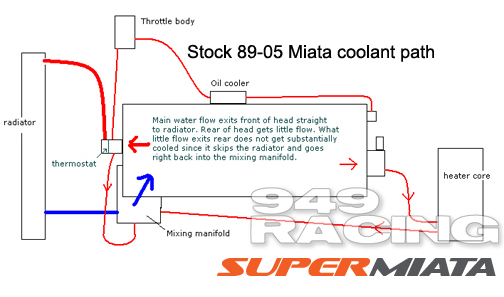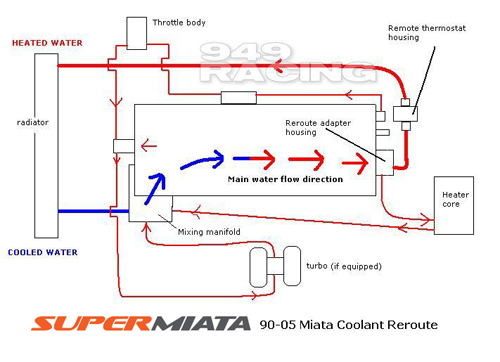Did you guys do a coolant reroute? The stock coolant route is pretty horrible and turbo just adds to the problem.
Our last race didn’t go well. Why? Just like at our race at Daytona, we almost-instantly managed to overheat our turbo Miata badly enough to end our race day early. We limped it around the track for a few hours, then finally called it quits after a bad oil leak and a bad exhaust leak sent us back to the paddock after a few hours on the track.
Now it was time to figure out what we’d broken. We knew our radiator was clogged, but assumed we’d hurt the engine, too. First step: a compression test. Thankfully, our Miata passed–though compression wasn’t very even across all cylinders. Oh well, we could live with that.
Compression is just one metric of an engine’s health, though. It measures how much pressure the engine can make while spinning. That single point of reference is valuable, but a better test is performed with a leak-down tester. This tool, worth about $75, measures the percentage of air loss in a cylinder. How does it work? Simple: Spin the engine until the cylinder you’re testing has all of its valves fully closed, then screw the leak-down tester in place of a spark plug and hook up air compressor. The tester will indicate what percentage of air is leaking out. A healthy engine will generally show less than 10% leak-down, while anything above about 20% is generally considered worth investigating. Another cool part about leak-down tests: You can usually determine where the air is leaking. Wind noise coming from the exhaust indicates a bad exhaust valve seal, while intake noise would point to the intake valves. Noise from the oil cap? That’s a sign of an issue with the piston or rings. If you notice wind noise coming from your radiator cap, that means you’re in the market for a new head gasket.
What did our leak-down test indicate? Let’s just say it wasn’t positive. We saw nearly 30% leak-down on two of our cylinders, with lots of air coming from our oil cap. Yep, air was leaking past our pistons.
Unfortunately, the bad news kept piling on. We turned our attention to the oil leak next, which started shortly before the end of our day at Sebring. After a thorough cleaning with some CRC Brakleen, we still couldn’t identify which hose or fitting was wetting down the side of our engine block. Then, we had a morbid thought: Maybe we’d blown our head gasket externally. To find out, we poured some UV dye into the car’s oil, then we started it up and watched for leaks with a UV light. Sure enough, fluorescent green dye started dripping out of the space between the head and the block, proving our hypothesis. In technical terms, we were boned. Goodbye shiny new Treasure Coast Miata engine, and hello broken Miata (again).
Did you guys do a coolant reroute? The stock coolant route is pretty horrible and turbo just adds to the problem.
Actually, I see from the pictures you did not. Check out the coolant flow on the Miata head, very little goes to the back two cylinders, turbos just make it worse. Check out below:

Removing the front water neck with a freeze plug and using a Kia or similar thermostat housing at the rear of the head, allows coolant to flow properly thru the engine.

iceracer said:Why the heated throttle body? Since EFI has no fuel to cause icing, it seems redundant.
It isn't fuel that could ice in this case, its the moisture in the air. So heating the throttle body to a constant 187 degrees is what Mazda decided to do. Honda does something similar to many of their engines as well. Obviously this is a situation that may only occur in certain circumstances, so for most of us it isn't an issue and can be safely eliminated.
iceracer said:Why the heated throttle body? Since EFI has no fuel to cause icing, it seems redundant.
AIUI, the moisture in the air can still ice it up if it's cold enough. I deleted them on mine because turbo car in California, but...
I came into this thread expecting the answer to be "the transmission".
So since this thread is totally hijacked now, sounds like I can route my coolant lines from the oil cooler around to the coolant bypass inlet and just skip the lines to the throttle body as I certainly don't want heat in my intake in a turbo application and winter driving is not in the cards....
dherr said:So since this thread is totally hijacked now, sounds like I can route my coolant lines from the oil cooler around to the coolant bypass inlet and just skip the lines to the throttle body as I certainly don't want heat in my intake in a turbo application and winter driving is not in the cards....
Sure. You can skip the factory oil warmer too, it doesn't really do much for cooling and is more about getting the oil up to temperature a bit faster. That lets you eliminate the entire intake-side coolant path.
Edit: You probably do need to keep the heat exchanger physically installed though, as a spacer.)
Displaying 1-8 of 8 commentsView all comments on the GRM forums
You'll need to log in to post.